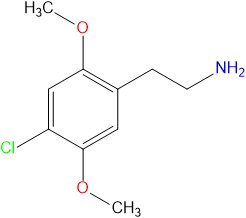2C-C
 |
This article is a stub. As such, it may contain incomplete or wrong information. You can help by expanding it. |
2C-C (2,5-Dimethoxy-4-chlorophenethylamine) is a psychedelic phenethylamine of the 2C-x family.[1] It was first synthesized by Alexander Shulgin and described in his 1991 book PiHKAL: A Chemical Love Story.
In modern times it is used as a recreational drug and an entheogen, rarely sold on the streets and almost exclusively obtained as a grey area research chemical through the use of online vendors.
Many users report that 2C-C is gentler and more sedating than other closely related psychedelic phenethylamines.
Chemistry
2C-B is a substituted phenethylamine with methoxy groups attached to carbons R2 and R5 as well as a chlorine attached to carbon R4.
Pharmacology
2C-E's psychedelic effects are believed to come from its efficacy at the 5-HT2A receptor as a partial agonist. However, the role of these interactions and how they result in the psychedelic experience continues to remain elusive.
Subjective effects
- soft tingly still all encompassing consistent warm mild mild in comprison to 2cb/e/i
- dishinibition
- mild visual disconnection
- ego suppression
- enhancement of colour
- visual supression
- visual disconnection
- thought suppression
- motor control suppression
- disconnective visual / cognitive
- entactogenic effects
Toxicity and Harm Potential
Lethal Dosage
The toxicity and long term health effects of recreational 2C-C use does not seem to have been studied in any scientific context and the exact toxic dosage is unknown. This is because 2C-C is a research chemical with very little history of human usage. Anecdotal evidence from people who have tried 2C-C within the psychedelic community suggests that there are no negative health effects attributed to simply trying this drug at low to moderate doses or using it very sparingly (but nothing can be completely guaranteed).
Tolerance and Addiction Potential
2C-C does not seem to be physically addictive and many users experience a self-regulating quality. There seems to be a tolerance build up when used consecutively multiple days in a row which could lead to a diminished experience. However, this effect is nearly non-existent when spaced 5-7 days apart.
Legal Issues
- United States: 2C-C is listed in schedule I of section 202(c) of the Controlled Substances Act in the United States, signed into law as of July, 2012 under the Food and Drug Administration Safety and Innovation Act.[2]
- Canada:
- United Kingdom:
- Sweden: 2C-C is classified as "health hazard" as of March 1, 2005 in their regulation SFS 2005:26, making it illegal to sell or possess.[3]
- Japan: 2C-C is controlled by the Pharmaceutical Affairs Law in Japan, making it illegal to possess or sell. [4]
See Also
References
- ↑ Alexander Shulgin - PIHKAL | http://www.erowid.org/library/books_online/pihkal/pihkal033.shtml
- ↑ S. 3187: Food and Drug Administration Safety and Innovation Act, Subtitle D-Synthetic Drugs | http://www.govtrack.us/congress/bills/112/s3187/text
- ↑ Svensk författningssamling | http://www.notisum.se/rnp/sls/sfs/20050026.pdf
- ↑ Analytical Data of Designated Substances (Shitei-Yakubutsu) Controlled by the Pharmaceutical AŠairs Law in Japan, Part I: GC-MS and LC-MS | https://www.erowid.org/references/texts/show/7395docid7635
